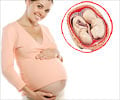Placental oxygen transport from mother to the baby could answer the question, why one twin is smaller than the other.
- Babies that are born smaller are associated with genetic or maternal risk factors like poor nutrition or smoking.
- Scientists have found a direct connection between twin babies that are born and placental oxygen.
- The study has found that slower transport of oxygen from the mother to the baby across the placenta are the reason why one twin is smaller than the other.
Studying Identical Twins
The research team was able to control both genetic factors and maternal risk factors while studying identical twins. Even though the twins share a placenta, they can be divided into two separate compartments one may be healthier when compared to the other.
The research team has developed a noninvasive method that could use MRI to map the timing of oxygen delivery across the placenta in real time.
The technique called Blood-Oxygenation-Level-Dependent (BOLD) MRI has showed that dysfunctional placentas in large regions with slow oxygen transport to the fetus.
P. Ellen Grant, MD, director of Boston Children’s Fetal-Neonatal Neuroimaging and Developmental Science Center said, "Until now, we had no way to look at regional placental function in vivo."
Mapping Placental Oxygen Transport
The new study which is a part of the NIH-funded Human Placenta Project has been carried out by following seven sets of identical twins who were all the way to birth. All of these were tracked in which one twin was smaller than the other.
The research team also measured the time taken for the oxygen to pass from the umbilical cord to the fetus and then penetrates to the brain and the liver.
The research team led by Polina Golland, PhD, MIT CSAIL has been found to use image correction algorithms to adjust fetal motion.
TTP Measurements
The researchers found that
Longer TTP in the placenta were correlated with lower liver and brain volumes and lower newborn birth weights.
When the placentas were examined after birth by placental pathologist Drucilla Roberts, MD, at Massachusetts General Hospital (MGH) it was found to correlate with placental pathology.
The scientists hope that the work will help to understand pregnancy risk factors and develops a prenatal test for mothers to improve care.
Grant said, "Our next goal is to figure out what causes variation in oxygen transport in the placenta and identify a cutoff value that would be of concern in a pregnancy, including singleton pregnancies."
"Then, we can think about potential treatments to improve placental oxygen transport, and use our methods to immediately assess the success of these treatments."
Future Research
The study on the placental oxygen transport can be an example of how the environmental factors can modify the DNA.
Further research will explain on how the placental oxygen transport can affect the gene expression and brain development.
These studies will use special MRI coil to study the image accuracy that can be developed of novel MR imaging strategies to improve the management of pregnant women.
David Weinberg, project lead for NIH’s Human Placenta Project, Eunice Kennedy Shriver National Institute of Child Health and Human Development, said, "The placenta plays a key role in fetal development and maternal health."
"Understanding how it functions is essential for developing interventions to improve the health of mothers and their infants."
References
- Jie Luo, Esra Abaci Turk, Carolina Bibbo, Borjan Gagoski, Drucilla J. Roberts, Mark Vangel, Clare M. Tempany-Afdhal, Carol Barnewolt, Judy Estroff, Arvind Palanisamy, William H. Barth, Chloe Zera, Norberto Malpica, Polina Golland, Elfar Adalsteinsson, Julian N. Robinson, Patricia Ellen Grant. In Vivo Quantification of Placental Insufficiency by BOLD MRI: A Human Study. Scientific Reports, 2017; 7 (1) DOI: 10.1038/s41598-017-03450-0
Source-Medindia










